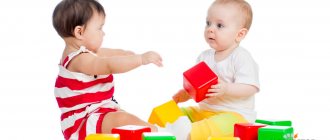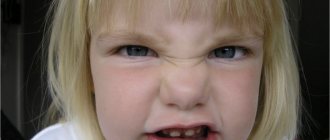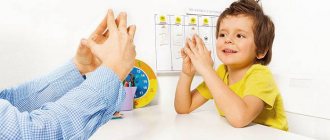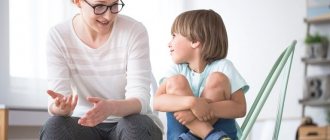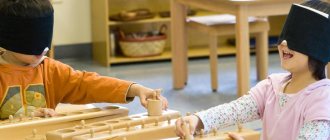Article:
Among the methods of early childhood development, the formation of sensory culture occupies a significant place. This is a gradual introduction of the child to the diversity of the outside world by influencing his senses - vision, hearing, tactile sensations, smell and taste.
What is the benefit of such development, at what age to start and can it be done at home? Read about this and other aspects of sensory integration in our article.
Why is sensory development necessary?
The sensory development of a child involves the formation of correct perception of the external properties of various objects:
- forms;
- colors;
- sizes;
- smell;
- position in space;
- taste.
It is sensory development that is considered a tool for understanding the world around us. Outstanding specialists in the field of pedagogy and child psychology (M. Montessori, E. I. Tikheyeva, O. Dekroli, etc.) in their works considered sensory perception as one of the most important factors of intellectual development. That is, the higher the child’s sensory culture, the smarter he is.
Sensory development is a basic component for mastering many skills:
- cognitive activity;
- thinking;
- communication;
- emotional intellect;
- imagination;
- memory and concentration.
In preschool age, any child’s activity—play, cognitive, physical—requires basic sensory development. For example, in order to fold a pyramid, you need to understand the difference in the sizes of the segments, and in order to play with a construction set, you need to understand the relationship and promising combination of parts.
History of Sensory Education in Montessori
Maria Montessori was not the first teacher to draw attention to the importance of developing children's senses. When developing her approach, she relied heavily on the work of the French physician and teacher Edouard Seguin, who at one time worked with children with special needs and created his own system of exercises for developing children’s perceptions and teaching them everyday skills. Jean-Jacques Rousseau and Johann Heinrich Pestalozzi in their works also paid attention to the role of the development of sensory organs in children's learning.
Robert Baden-Powell, founder of the Scout movement and contemporary of Maria Montessori, said that to gain knowledge about the world, children need real experience of interacting with objects. This statement formed the basis of his theory of active learning. He highly valued Maria Montessori's pedagogical approach, noting that if teachers stop commanding and begin to more delicately reinforce a young child's natural need for new experiences, teachers can create a much more solid basis for subsequent learning and development. In his opinion, the idea of education as hard and exhausting work is hopelessly outdated.
Maria Montessori herself began her career working with special needs children who were deprived of adequate sensory stimulation: they had almost no toys, and their whole life was reduced to a series of basic caregiving activities. She was able to clearly prove that changing the living conditions of children significantly changes the level of their abilities. Today, the influence of the environment on a child’s development has been proven at the neurophysiological level. We recommend reading John Medin's book, Rules for Your Child's Brain Development, to become more familiar with this topic.
Maria Montessori created a system of sensory education based on many years of experience observing children and studying the works of outstanding teachers and doctors. Although she was not the first to discover the need for sensory experiences in child development, she was certainly the first educator who was able to draw public attention to this fact.
At what age to start
Numerous studies have shown that the process of sensory perception is most actively formed from 2 to 4 years. Based on surveys of parents, it was possible to find out: children with whom classes on sensory development were conducted are noticeably ahead of their peers in intellectual terms. They are more inquisitive and active, absorb information more easily, and have a good memory.
However, it is possible to develop sensory perception earlier - there are methods for the early development of children from 1 year and even earlier.
Games for developing abilities
In order for children to develop sensory abilities, there are many games and exercises:
- A game for developing tactile sensations “Recognize the figure.” Several different figures are placed in a bag, and then the same ones are laid out on the table. The teacher shows the children a figure and asks them to take the same one out of the bag. Children should find the desired figure in the bag by touch. The lesson is intended for children 3-4 years old.
- Exercise to develop auditory perception. A variety of objects are poured into several glass bottles: peas, beans, sand, pebbles, buttons, etc. Then the baby is asked to shake each bottle and draw what he heard. Children 4-5 years old do an excellent job with this task, since it is intended specifically for them.
- Exercise to develop visual perception. To do this, take any transparent object: a bottle of colored glass, a jar of colored water, a magnifying glass, etc. and ask the child to look at the indoor flower through each of these objects. Then you can ask the child to share his feelings and draw a flower, the way he saw it through these objects. The result will be several drawings, which can then be discussed. The game is designed for children 5-7 years old.
Norms of child sensory development
Despite the individual characteristics of each child, there are age-related standards for sensory development:
✓ 6-12 months. The child gets acquainted with the world around him and is enriched with impressions. During the first year of life, he learns to follow bright, moving objects. To get to know each other better, the baby grabs with his hands what is in the access zone. Tastes, examines and evaluates by touch.
✓ 2-3 years. Kids know the basic colors, shapes and sizes of objects, and have an idea of their combination. They can fold a pyramid and a sorter. Perform tasks that require the skill of grouping objects that differ from each other by 1-2 characteristics.
✓ 4-5 years. At this age, sensory standards appear - stable ideas about the colors, shapes, and sizes of surrounding objects. The child knows and distinguishes not only the basic palette, but also shades and halftones. Traces the relationship between elements of the same series, easily systematizes a large number of objects.
✓ 5-6 years. The period of development of descriptive activity. A child can characterize an object according to 3-5 parameters, draw it, and mold a prototype from plasticine. Performs complex visual actions - can tell how close or far a thing is located. He has developed analytical perception: the ability to single out the main object from similar ones, assemble a single form from many segments (construction), and combine colors under a certain condition.
There are 4 sensory perception systems. Let's look at each of them:
1. Touch (tactile perception). Trained by touching various objects/surfaces with hands and other parts of the body.
How to develop:
- give the child toys of different textures (fabric, metal, wood, plastic);
- wear clothes made from fabrics of different textures and densities. Draw the child’s attention to differences in fabrics, ask them to evaluate the level of comfort and describe the sensations of this or that clothing;
- massage using massage devices (brushes, pimply balls, massagers, creams, oils);
- draw on the body with your fingers or a brush. Allow the child to smear himself with special non-toxic water-soluble paints, and then wash them off in the bathroom;
- develop the sensitivity of the feet - walking on different surfaces without shoes, sensory mats (sewn chestnuts, pebbles, beads).
2. Vision. Trains in good lighting conditions, in daylight, on walks. The bright interior of the room, harmonious space and periodic change of environment contribute to vision training.
How to develop:
- travel a lot, visit new places, show the child various objects of infrastructure and nature: house, lake, forest, mountain, factory, sea wave, railway, etc.;
- surround the child with things of natural shades, train the perception of halftones (for example, distinguish turquoise from light blue); give pictures to look at - images of nature, animals. Show works of art, photographs. The number of details and the intricacy of plots should increase. Conventionally, for a two-year-old - a watermelon, for a five-year-old - Aivazovsky;
- learn to describe the properties of objects in the field of view, focus on colors, shapes, sizes;
- train your eye - how far away this or that object is. You can demonstrate the distance in steps, and then ask the child to mentally count the approximate number of steps to the selected object.
3. Smell and taste. The baby's diet in the first months of life is not varied, so the development of taste sensations begins with the first complementary foods - at about 6 months. Babies recognize smells from the first minutes of life. It is important to keep the air in your baby's room clean.
How to develop:
- walk more with your child, especially in the warm season, when the air is filled with the smells of flowering plants;
- replenish the child’s “database” of smells - voice them, so that later he can identify different aromas himself. For example: the smell of rain, mushrooms, soap, baking, etc.;
- introduce a variety of foods into the child’s diet, introduce new tastes;
- explain shades of tastes: sweet, bitter, sour, tart, viscous, fatty/non-fatty;
- correlate tastes with certain products, forming sensory standards: sweet raspberries, sour tangerines, salted fish, etc.;
- give the child food of different density and texture, teach the characteristics of products: the bun is sweet, soft, fluffy, aromatic.
4. Hearing. This type of sensory perception begins to form in the womb, so training can begin during pregnancy. Talk to the baby in the tummy, turn on pleasant music, avoid unpleasant, loud sounds.
How to develop:
- talk to the baby in different voices - change the timbre depending on the mood, situation;
- read fairy tales, imitating the characters’ speech;
- include a variety of music, explain its genre, give characteristics: calm, energetic, beautiful, heavy, sad; sing lullabies;
- during incidents (the child fell, fell ill), calm with your voice;
- introduce your child to musical instruments, buy him interactive sound toys;
- demonstrate what sounds household objects can make: a carrot on a grater, a comb on hair, a broom on the floor, etc.;
- learn to imitate the sounds of nature and the voices of animals and birds.
Rules for organizing sensory education according to Montessori
Maria Montessori noticed that at a certain age, children's behavior and motivation are very similar. For example, in the first three years a child is especially sensitive to order. This childish “pedantry” is necessary for the child to create a stable image of this world. It can also be used to develop a child’s natural need for knowledge by creating tasks that are exciting for a certain age, which would help the child master the most important qualities of objects: color, size, shape, material.
As Maria Montessori herself admitted, the work of creating the sets was not easy: it was necessary to create material that would demonstrate properties in isolation, have pedagogical value, and at the same time be attractive to the child. This is how a set of Montessori sensory material appeared.
The main objectives of Montessori sensory exercises
- Teach the baby to perceive, compare and classify sensory experiences of different modalities,
- Expand the child’s sensory experience, teach him to notice even small differences, develop the child’s senses as much as possible,
- Teach your child to use his own memory: “I remember what yellow is, and I can always imagine it in my head,”
- Teach to critically evaluate any information and develop the habit of striving for maximum accuracy when gaining knowledge about the world,
- Create a basis for the emergence of abstract thinking and imagination.
Let us explain with an example how sensory and abstract thinking are connected:
Let's say you've never seen an okapi. Now your task is to imagine this animal by description: it is a bay horse with the legs of a zebra and the head of a giraffe. Happened? If so, congratulations, your sensory development is on point, because for this exercise you need to have an understanding of the colors of horses, the coloring of a zebra and the body structure of a giraffe.
Any abstract idea is essentially a clever interweaving of various information from our real experience. That is why a child’s intelligence begins in early childhood and the ability to exercise all the senses over and over again.
What can you find in the sensory development area of the Montessori center?
Visual information
- Shapes: sets of geometric shapes, as well as more complex shapes (for example, animal figures or plant leaves)
- Volumetric figures: Pink Tower, Brown staircase, Red barbells, Montessori weight cylinders
- Colors: sets of basic colors, card index of shades
Tactile information
- Texture: palpable board, rough tablets, baskets with rags
- Temperature: heat jugs, heat plates
- Weight: weighing cylinders and plates
Stereognostics
- Sorting small items, magic bag
Audio information
- Volume: sound boxes, musical accompaniment of classes
- Height: bells, sound cylinders, musical instruments
Taste and smell
- Taste bottles, conversations during meals
- Jars with scents
In addition to exercises with isolated sensory qualities, in a Montessori space you can always find sets that combine several qualities, such as color and shape:
- Binomial cube
- Trinomial cube
- Constructive triangles
- Montessori squares
- Cylinders without handle
The study of sciences according to M. Montessori also begins with sensory education. Acquaintance with the basic qualities of objects of the natural and cultural world prepares the child for studying social sciences, biology, physics, chemistry and even mathematics:
- Sets of leaves of different plants
- Thematic puzzles
- Maps and globe
- Flags
- Sets with natural materials
- Reproductions of artists and nature photographs
At home or in a development center?
There is no shortage of sensory integration specialists today. Developmental centers, correctional institutions, children's clubs, psycho-educational clinics. offer various sensory development programs for children 1-6 years old.
Advantages of their services:
- Specialists with confirmed qualifications: psychologists, teachers, special education teachers, speech therapists, etc.
- Material and technical base for comprehensive sensory development.
- Individual approach to the needs and skills of each child.
- Possibility of group classes, when sensory perception is trained during a group game.
- Professional diagnosis of the child’s abilities and assessment of progress achieved.
However, if you do not have the opportunity to attend such classes, it does not matter. Almost all types of sensory development can be implemented at home. Methodological literature and special devices will help you.
What you will need
An approximate list of devices for the sensory development of a 2-3 year old child:
- painting supplies;
- musical instruments;
- modeling dough, soft clay, multi-colored sand;
- sorters, loose-leaf books, pyramids, nesting dolls;
- children's books, magazines;
- sensory rugs (sew chestnuts, beans, walnuts, buttons, beads, sequins onto a towel);
- pieces of fabrics of different colors and textures;
- mosaics, construction sets (“Velcro”, magnetic);
- cubes, Dienesh blocks, Cuisenaire sticks;
- objects made of different materials: wood, clay, straw, felt, steel, glass, plastic.
